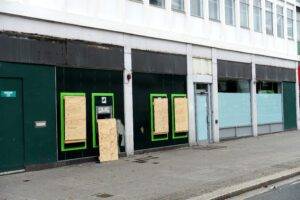
The number of UK bank branches that have permanently closed their doors over the past nine years will surpass 6,000 on Friday, a milestone that highlights the significant impact on local communities.
The consumer group Which? has published these figures as part of its effort to bring attention to the widespread closures and their detrimental effects, urging this issue to become a focal point in the upcoming general election.
Eight Barclays branches are set to close on Friday, bringing the total number of closures since 2015 to 6,005. Barclays alone is responsible for approximately 20% (1,216) of these closures, leading the tally among major banks.
Surge in Closures
The rate of closures peaked in 2017 but seemed to slow down until a recent surge. Which? accuses banks of engaging in a “race to close branches” following the government’s 2020 announcement of potential laws to protect access to cash, which could complicate branch closures if alternative provisions are lacking.
Banks justify these closures by pointing to a significant shift in customer behavior, with more people favoring online and mobile banking over traditional counter services. However, the trend has left many without convenient access to in-person banking services.
Future Banking Blackspots
By the end of the year, 33 parliamentary constituencies, including Erith and Thamesmead, Dagenham and Rainham in London, and Sedgefield, the former seat of Tony Blair, are expected to be without a single bank branch.
Impact on Communities
While millions have transitioned to digital banking, a considerable number of people, particularly those less tech-savvy, still rely on physical branches. The closures have forced some customers to travel long distances for essential services, such as registering power of attorney, which many banks require to be done in person.
Sam Richardson, Deputy Editor of Which? Money, noted that while some might not notice the closure of their local branch, “for others reliant on face-to-face services, the impact can be disastrous.”
Call to Action
With a general election on the horizon, Which? is advocating for the next government to commit to establishing at least 200 banking hubs within the first two years post-election. These hubs, managed by Post Office staff, offer services such as cash withdrawals, deposits, bill payments, and other regular transactions, essentially functioning as standard bank branches.
Response from Banks
Barclays, named as the bank with the most closures, stated: “As visits to branches continue to fall, we need to adapt to provide the best service for all our customers. Where levels of demand don’t support a branch, we maintain an in-person presence through our Barclays Local network, live in over 350 locations, based in libraries, town halls, mobile vans, and our banking pods.”
Constituencies Expected to Have No Bank Branches by Year-End
Barnsley East (Population: 94,000)
Bolton West (98,000)
Bradford South (106,000)
Bury South (103,000)
Central Suffolk and North Ipswich (102,000)
Chatham and Aylesford (103,000)
Clwyd South (70,000)
Colne Valley (112,000)
Dagenham and Rainham (117,000)
Denton and Reddish (88,000)
Don Valley (99,000)
East Worthing and Shoreham (99,000)
Erith and Thamesmead (117,000)
Glasgow North East (88,000)
Liverpool, West Derby (94,000)
Mid Bedfordshire (121,000)
Mid Derbyshire (83,000)
Newport East (84,000)
North East Derbyshire (92,000)
Nottingham East (98,000)
Penistone and Stocksbridge (89,000)
Plymouth Moor View (94,000)
Reading West (112,000)
Rhondda (68,000)
Sedgefield (85,000)
Sheffield Hallam (85,000)
St Helens North (100,000)
Stone (86,000)
Swansea East (81,000)
Warrington North (95,000)
Wentworth and Dearne (100,000)
Wirral West (68,000)
York Outer (92,000)
The ongoing wave of branch closures underscores the urgent need for solutions to ensure accessible banking services for all communities, particularly those who rely heavily on face-to-face interactions.
Read more:
More Than 6,000 UK Bank Branches Closed in Nine Years Amidst ‘Disastrous’ Impact






